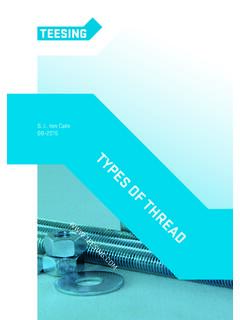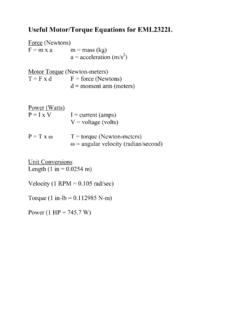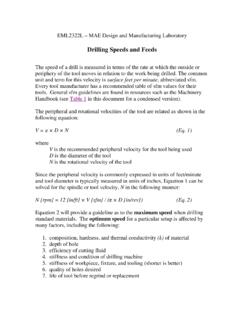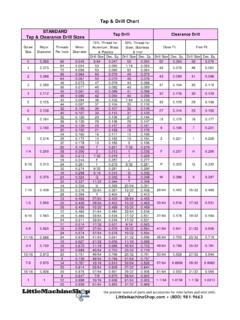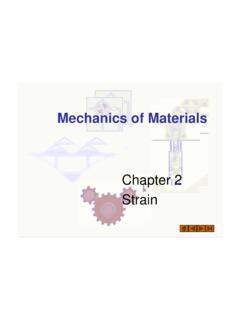Transcription of 0.1. Failure Theories - University of Florida
1 3 Failure Theories In the previous section, we introduced the concept of stress, strain and the relationship between stresses and strains. We also discussed Failure of materials under uniaxial state of stress. Failure of engineering materials can be broadly classified into ductile and brittle Failure . Most metals are ductile and fail due to yielding. Hence, the yield strength characterizes their Failure . Ceramics and some polymers are brittle and rupture or fracture when the stress exceeds certain maximum value. Their stress strain behavior is linear up to the point of Failure and they fail abruptly.
2 The stress required to break the atomic bond and separate the atoms is called the theoretical strength of the material. It can be shown that the theoretical strength is approximately equal to E/3 where, E is Young s However, most materials fail at a stress about one hundredth or even one thousandth of the theoretical strength. For example, the theoretical strength of aluminum is about 22 GPa. However, the yield strength of aluminum is in the order of 100 MPa, which is 1/220th of the theoretical strength. This enormous discrepancy could be explained as follows. In ductile material yielding occurs not due to separation of atoms but due to sliding of atoms (movement of dislocations) as depicted in Figure Thus, the stress or energy required for yielding is much less than that required for separating the atomic planes.
3 Hence, in a ductile material the maximum shear stress causes yielding of the material. In brittle materials, the Failure or rupture still occurs due to separation of atomic planes. However, the high value of stress required is provided locally by stress concentration caused by small pre-existing cracks or flaws in the material. The stress concentration factors can be in the order of 100 to 1,000. That is, the applied stress is amplified by enormous amount due to the presence of cracks and it is sufficient to separate the atoms. When this process becomes unstable, the material separates over a large area causing brittle Failure of the material.
4 Figure : Material Failure due to relative sliding of atomic planes Although research is underway not only to explain but also quantify the strength of materials in terms of its atomic structure and properties, it is still not practical to design machines and structures based on such atomistic models. Hence, we resort to phenomenological Failure Theories , which are based on observations and testing over a period of time. The purpose of Failure Theories is to extend the strength values obtained 1 Anderson, Fracture Mechanics Fundamentals and Applications, Third Edition, CRC Press, Boca Raton, FL, 2006.
5 4 Finite Element Analysis and Design from uniaxial tests to multi-axial states of stress that exists in practical structures. It is not practical to test a material under all possible combinations of stress states. In the following, we describe some well-established phenomenological Failure Theories for both ductile and brittle materials. strain Energy When a force is applied to a solid, it deforms. Then, we can say that work is done on the solid, which is proportional to the force and deformation. The work done by applied force is stored in the solid as potential energy, which is called the strain energy. The strain energy in the solid may not be distributed uniformly through out the solid.
6 We introduce the concept of strain energy density, which is strain energy per unit volume, and we denote it by U0. Then the strain energy in the body can be obtained by integration as follows: ( , , )oUUxyzdvV ( ) where the integration is performed over the volume V of the solid. In the case of uniaxial stress state stain energy density is equal to the area under the stress strain curve (see Figure ). Thus, it can be written as 012U ( ) For the general 3-D case the stain energy density is expressed as 012xxyyzzyzyzzxzxxyxyU ( ) If the material is elastic, then the strain energy can be completely recovered by unloading the body.
7 The strain energy density in Eq. ( ) can be further simplified. Consider a coordinate system that is parallel to the principal stress directions. In this coordinate system, no shear components exist. Extending Eq. ( ) to this stress states yields 01 12 23 31()2U ( ) Chap. 2 Uniaxial Bar and Truss Elements 5 Figure : Stress strain curve and the strain energy From Section , we know that stresses and strains are related through the linear elastic relations. For example, in case of principal stresses and strains, 1123221333121()1()1()EEE ( ) Substituting from Eq. ( ) into Eq. ( ), we can write the strain energy density in terms of principal stresses as 22201231 22 31 312 ()2UE ( ) The strain energy density can be thought of as consisting of two components: one due to dilation or change in volume and the other due to distortion or change in shape.
8 The former is called dilatational strain energy and the latter distortional energy. Many experiments have shown that ductile materials can be hydrostatically stressed to levels beyond their ultimate strength in compression without Failure . This is because the hydrostatic state of stress reduces the volume of the specimen without changing its shape. Decomposition of strain Energy The strain energy density at a point in a solid can be divided into two parts: dilatational strain energy density Uh that is due to change in volume, and distortional strain energy density, Ud, that is responsible for change in shape.
9 In order to compute these components, we divide the stress matrix also into similar components, dilatational stress matrix, h, and deviatoric stress matrix, d. For convenience we will refer the stresses to the principal stress coordinates. Then the aforementioned stress components can be derived as follows: U strain energy E i i 6 Finite Element Analysis and Design 1122330 00 00 00000000 00 00 0hdhdhd ( ) The dilatational component h is defined as 12333xxyyzzh ( ) which is also called the volumetric stress. Note that 3 h is nothing but the first invariant I1 of the stress matrix in Thus, it is independent of coordinate system.
10 One can note that h is a state of hydrostatic stress and hence the subscript h is used to denote the dilatational stress component as well as dilatational energy density The dilatational energy density can be obtained by substituting the stress components of the hydrostatic stress state in Eq. ( ) into the expression for strain energy density in Eq. ( ), 222212 ()2(1 2 )32hhhhhhhhhhhUEE ( ) and using the relation in Eq. ( ), 21232221231 22 31 3(1 2 )323122()6hUEE ( ) Distortion Energy The distortion part of the strain energy is now found by subtracting Eq. ( ) from Eq. ( ), as 02221231 22 31 322212233113132dhUUUEE ( ) It is customary to write Ud in terms of an equivalent stress called von Mises stress VM as 213dVMUE ( ) The von Mises stress is defined in terms of principal stresses as Chap.
